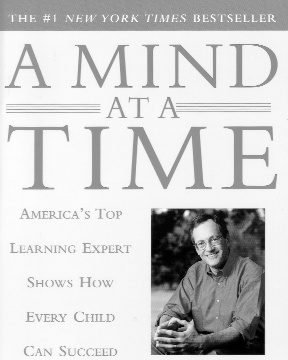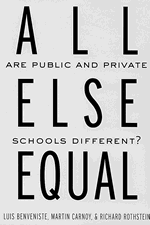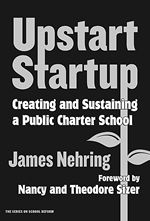
The Dumbest Generation: How the Digital Age Stupefies Young Americans and Jeopardizes Our Future
by Mark Bauerlein
Jeremy P. Tarcher/Penguin 2008, $24.95; 272 pages.
As reviewed by Ted Kolderie
The Dumbest Generation is an assault on people under 30. In chapter after chapter, the author, a professor of English at Emory University, rails at how little they know, how little they read, and how their fascination with screens (television and computer) fails to produce learning.
What they write is full of “bad grammar, teen colloquialisms and shallow ironies.” Books are losing out. Unlike many, the author worries about the consequences less for the country’s economic future than for its intellectual future. “We need a steady stream…of strong military leaders and wise political leaders, dedicated journalists and demanding teachers, judges and muckrakers, scholars and critics and artists.” The problem is not so much school as it is what young people do in their private time: their “social and leisure dispositions are killing the culture, and when they turn 40 and realize what they failed to learn it will be too late.”
Bauerlein is even angrier with the “digital enthusiasts,” who equate an interest in the new media with learning, “the custodians of culture…the teachers, professors, writers, journalists, intellectuals who will not insist upon the value of knowledge and tradition.” And he is especially angry with those who tell young people they are a wonderful generation, the vanguard of a new literacy.
Surely not all young people are Zipper Harris in Doonesbury. Perhaps medieval scholastics felt the same way about printing.
But let’s stipulate the behavior he describes, even its consequences. Let’s agree that the digital age does stupefy young Americans, that it does jeopardize our future, and that teenagers are ignorant, unaccomplished, and unengaged except in their friends, music, clothes, and digital devices.
What to do? Well, we might start with a question Bauerlein does not ask: Is the problem with adolescents or with adolescence?
Psychologist Robert Epstein, at the University of California San Diego, in The Case Against Adolescence, agrees about the moronic behavior of many teenagers. But he explains: Adolescence infantilizes young people. Deny them serious responsibilities, keep them out of real work, give them virtually no contact with adults, tell them they have no function except to be schooled…why wouldn’t they behave as they do?
Sheldon White, while professor of psychology at Harvard, described adolescence as “a separate society” for the young, prolonging childhood. It was created by a coming together of the child-labor laws 100 years ago, the new high schools, and special legislation for juvenile offenders. After 1950 its effects were compounded by the shift public-opinion analyst Daniel Yankelovich details in New Rules from the ethic of self-denial to the ethic of self-fulfillment. So many people had so much money it was impossible to say “No” to cars, clothes, guitars, computers. No wonder youth behavior changed dramatically. Adults imposed new rules, which bred resistance and defiance, which produced still more restrictions. Curfews. Can’t drive. Can’t drink. “No entry except with adult.” Blocked access to the Internet. Criminalize sex under 18. No cigarettes. Dress codes. “Parental consent required.” And in school, metal detectors, video surveillance, armed guards, and No Cell Phones!
“Our high schools used to be filled with children,” Mary Lee Fitzgerald said in July 1999 while directing education programs for the Wallace Foundation. “Today they’re filled with people who are essentially adults—being treated still as children.” Young people are not challenged with serious responsibilities. Instead, they are told, education is the way up. The world of work is closed until you have the credentials. So study hard. Yet the schooling we offer is one that most find neither motivating nor relevant, offering them little say in what they study or how they learn or in the way their school runs.
When challenged, young people can perform impressively. Writing about the years 1815 to 1830, Paul Johnson described in The Birth of the Modern the remarkable accomplishments of teenagers from truly disadvantaged backgrounds. With little formal education they started work early and, importantly, were allowed to rise as fast as their abilities would take them. Michael Faraday, the scientist, “was born poor, son of a blacksmith. He had only a few years at a school for the poor, but as a bookbinder’s apprentice he read the works he bound.” Henry Maudsley, “perhaps the greatest of all the machine-tool inventors, began work at 12 as a powder-monkey in a cartridge works.” Matthew Murray, “the great engine designer, began as a kitchen boy and butler.”
In The Maritime History of Massachusetts 1783–1860, Samuel Eliot Morison writes about Mary Patten, wife of the captain of a clipper ship. “In 1858 on a voyage around Cape Horn, her husband fell ill. The first mate was in irons for insubordination; the second mate was ignorant of navigation. Mrs. Patten had made herself mistress of the art of navigation during a previous voyage. She took command, and for 52 days she navigated the ship of 1800 tons, tending her husband the while, and took both safely into San Francisco.” She was 19.
Bauerlein almost gets there. “Young Americans are no less intelligent, motivated, ambitious and sensitive than ever…. It’s not the under-30s who have changed…(but) the threshold into adulthood, the rituals minors undergo to become responsible citizens, the knowledge and skill activities that bring maturity and understanding.” The digital realm could aid in that, he says, “but not the way young people use it. The popular digital practices of teens and 20-year-olds…close the doors to maturity, eroding habits of the classroom…” But he proposes no changes in school or in society to offer them serious responsibilities for learning and for life. His remedy is essentially to take young people by the shoulders and shake ’em until they come to their senses about the need to be serious in school, to read books, and to think. And here we come to the issue. This is what many in the policy discussion favor and seem to believe will work.
The other approach is what Epstein proposes: Move the young people who can demonstrate maturity into adult life. Epstein would let them “test out” of adolescence. John Goodlad years ago suggested ending high school at age 16. Minnesota now has schools in which young people make more decisions, individually about the pace and nature of their learning and collectively about the rules by which their school runs. Get beyond the technology of teacher instruction; let students explore the world of organized information now available digitally, with teachers as their guides. Let them do real work, for money and for academic credit.
The education policy discussion needs to consider all this because, as White noted, school is part of the institution of adolescence. Almost certainly this country could be getting far more from its young people than it is. We know how to design and run schools that treat young people as adults. These exist. They work. But they are marginalized by a policy discussion that is locked into narrow conceptions of learning and of achievement and into a concept of adolescence it does not even think to question.
Ted Kolderie is senior associate with Education|Evolving.





